today i wanted to go over the details of my trip to lovely belfast, northern ireland. you know, that place once engulfed in a protracted and bloody civil war that had the notorious irish republican army (IRA), who were largely catholic, and their counterparts in cruelty, the mostly protestant ulster defense association, planting bombs aplenty throughout the region. together, they blew up and assassinated about 3,500 people -- most of them hapless civilians -- in about 30 years. the protestants/unionists want british rule to prevail in the area, and it does, while the catholics/republicans want to throw the brits out altogether and reunite with their ruddy-faced brothers in ireland. so don't confuse the two irelands. they hate that shit.
you know, it really baffles me that two super similar bible-based religions can get so low down and dirty over the details. ok, israelis and palestinians i can understand, but these guys share one book. it seems that the people hate each other out of habit than because of any fundamental difference in lifestyle. in the wise words of rodney king, "can't we all just get along?" and speaking of mr. king, belfast really reminds me of an irish version of south central los angeles, where people are still dying daily from gang violence (and more so in recent months), though no one seems to be making a fuss over that. the neighborhoods of both areas are segregated, and crossing into foreign turf could cost you your life. but instead of bloods and crips, northern ireland has its "prods" (protestants) and "finnions" (catholics). and while the denizens here are sucking in their irish ales, their LA gang counterparts are downing their "40s." what's more, all the fighting that's going on is essentially between members of the same race. yet the US authorities, both federal and local, have done little to solve the conflict, which is taking place on american soil. i wonder why.
anyhow, in 1997, the consummate diplomat bill clinton came in and urged all to lay down their weapons and sign the Good Friday Peace Agreement, which basically established a power-sharing assembly that forced the leaders of both camps to sit down in the same room together and write laws for the region. but considering their long history of animosity, accusations of spying and all kinds of shady dealings soon followed, prompting our friend tony blair to dismiss the assembly and cancel the next round of elections. so things are pretty tense, and the divisions in the populace are just as real today as they ever were. rogue paramilitaries still set off the odd bomb and religion-driven murders are still commonplace. so i'll admit that entering this area did make me feel a bit uneasy, which was worsened by the fact that the class was staying at the europa hotel, a fancy hotel in the center of town owned by the british and bombed continuously by the IRA during the civil war's heyday.
the integrated school: the principle of this school should really get a medal for what he's doing. he and a few other forward-thinking teachers got together about 10 years ago and decided to mix schoolchildren of both religions, so future generations could unlearn this cycle of hate. now the school has about 800 students, but, sadly, integrated schools (there are several in northern ireland, and more popping up) only draw about five percent of the country's schoolchildren. he spoke to us very eloquently about the joys and sorrows of running such a school, and let us in on a very fascinating secret: the members, even leaders, of some of the warring paramilitary organizations send their kids to that school, sometimes covertly so they don't attract the fire of their jingoistic communities.

sinn fein in the membrane: sinn fein means "ourselves" in gaelic, and the organization (pronounced SHIN FEIGN) is the political and very popular arm of the IRA. its party members have been gaining power steadily, which makes the british government and their irish minions quite nervous. we met with a representative, owen o'bryn, who's rumored to be the successor of gerry adams, sinn fein's current head. o'bryn was charismatic, funny, articulate, intelligent, diplomatic -- all the good things that will one day make him an able leader. these are also things that make him a skilled dodger capable of talking his way around any issue, as he did with the class' inquiries into the scandals surrounding his organization, most notably the whole stakeknife affair.
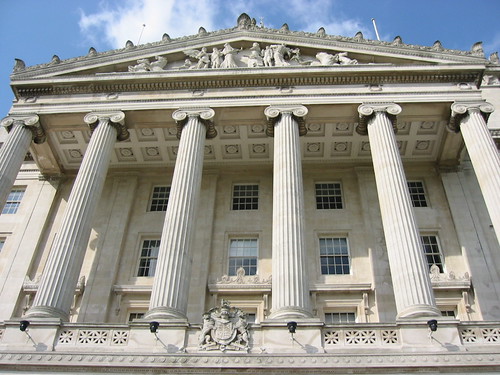
why do all government buildings have to look like this? the stormont building: another architectural throwback to the holy roman empire.
stormont: unfortunately, some kind of scheduling conflict prevented us from getting the unionist side of the argument, so we parted with our kind sinn feiner and made our way to stormont, the building that houses (or housed, considering it's been dissolved), the northern irish assembly. there we met a tour guide who showed us around the immense joint and took questions. the most interesting thing i learned from that experience was that the lecterns where house leaders must stand to give their statements contain a bunch of religious books: bible, torah, book of mormon, even a copy of the koran. (as if that would really keep politicians from lying.)
friday night fright: what else could a bunch of american girls in belfast do on a friday night if not go out and drink? and who better than the locals to drink with? for starters, the people i met in belfast are a million times freer and funner than the stuffy english. and even though the area's a bit poorer, no one hesitated to buy you a drink -- a rarity in london. the people also seemed a bit more intense, often somber, in the way people who've survived something tragic gain new insight into life. the people in belfast definitely carried that kind of air.
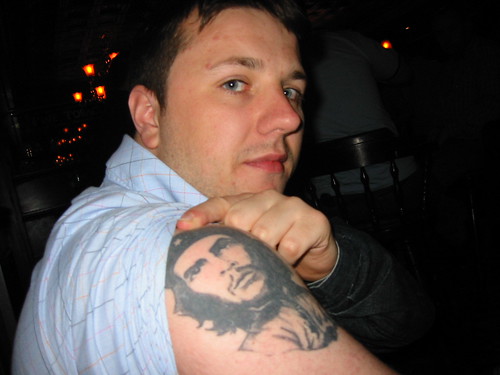
neil (or maybe neal?), pictured above, had that air. he was a catholic, irish republican who made no secret of his contempt for the unionists. he told us stories of "his best mates" being shot dead by the unionists, and how he thought the republicans should keep fighting until they drive out the british entirely. he became more passionate about this point as the night (and his blood alcohol level) progressed. some of the girls and i hung out with him and his friend, eventually making our way to the pub's upstairs nightclub, where we all danced to disco. for a minute there, i forgot i was in belfast.
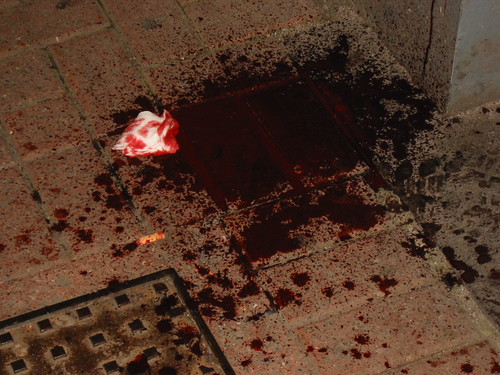
at the end of the night, neil got into a bloody fight with some goon who was trying to hit on all the girls in the club, including us. i'm not sure whether it was also related to religion or party politics; all i know is that when i made my way to the street to see what happened, blood spotted the sidewalk, and neil was giving a statement to the cops while a guy whom i think was the goon (or maybe his friend) was getting his arm bandaged by paramedics. i ran inside to get the girls and by the time i came back out neil was gone.

the peace wall: on saturday, the class boarded a bus for a tour of belfast. we saw all the divided neighborhoods and communities, which identified their allegiance by flying either the union jack or irish flag on each lamppost. we saw the areas hardest hit by the violence; some buildings remained bombed-out and charred. the tour guide told us gruesome stories of assassinations and bombings that left so much carnage in their wake. it was a mind-blowing, moving experience. we drove the length of the miles-long shankill/falls road wall (the republicans call it "falls road," the unionists "shankill road"), otherwise known as the "peace wall," which keeps the communities segregated. the wall is covered in murals and written messages on both sides, most of them kind, but some not so kind.
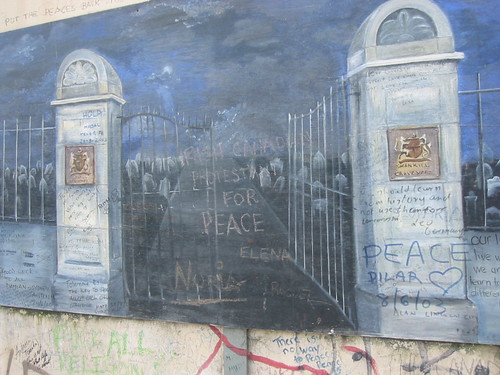
a mural on the peace wall
it's crazy to see how near each other these divided communities live. sometimes simply crossing the street can put one in enemy territory. most of these neighborhoods featured working-class, if not a bit scuzzy, homes. we then toured the integrated neighborhoods, where flying patriotic flags is prohibited. that was uplifting, a reminder that there's still hope for this area, though full-fledged integration seems a long ways away. it's kind of like the civil-rights movement in the states. those first five years after the south desegregated were fragile times indeed, but now some 40 years later, relations between all races have improved and should only continue to improve in the future. once warring groups are less divided and more united. well, maybe not in south central.
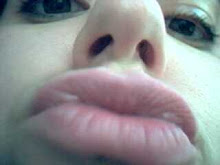





1 comment:
Hello In my opinion you are wrong. Let's discuss it.
Post a Comment